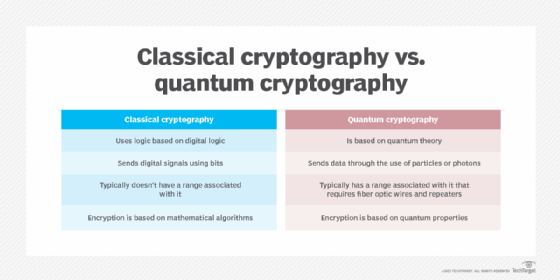In the vast and intricate realm of cryptography, we are presented with a fascinating dichotomy: classical and quantum cryptography. Imagine for a moment a vast, labyrinthine castle, fortified with high walls and a singular entrance. The established security system is formidable, relying on complex locks and intricate codes to guard valuable treasures within. This castle symbolizes classical cryptography, which has served humanity for centuries, securing communications through a variety of algorithms and protocols. However, as technology advances, the very structure that once seemed impregnable now shows signs of vulnerability, much like that same castle that now faces an invisible enemy lurking just beyond its walls.
On the other side of this metaphorical divide lies a new paradigm—quantum cryptography, a burgeoning field that harnesses the principles of quantum mechanics to safeguard information. To illustrate this, one might envision a mystical gatekeeper, capable of reading the thoughts of intruders before they even approach the castle. This is the essence of quantum cryptography; it not only creates a barrier but also a sentinel that can anticipate and neutralize potential threats. It is well worth exploring how these two contrasting forms of cryptography coexist, the threats they face, and the evolutionary trajectory of securing our digital future.
Firstly, understanding classical cryptography requires delving into its foundational pillars, specifically symmetric and asymmetric encryption. Symmetric encryption employs a single key for both encryption and decryption, akin to sharing a single key between two parties to access a locked chamber. This method has a performance advantage—swift and efficient. However, its major pitfall is the challenge of key distribution. What happens when the entrusted key falls into the wrong hands? The entire system crumbles like a house of cards. Asymmetric encryption, or public key cryptography, proposes a different tactic, involving a pair of keys: a public key, which can be shared openly, and a private key, which must remain confidential. This dual-key system enhances security but often at the expense of computational efficiency.
Despite its robust historical significance, classical cryptography faces relentless challenges. The advent of powerful quantum computers threatens to unravel the very fabric of cryptographic security. Quantum computing, where information is processed using the principles of quantum bits or qubits, presents the potential to shatter traditionally secure encryption methods. Classical algorithms like RSA and ECC could be rendered obsolete in the face of Shor’s algorithm, which can factor large integers exponentially faster than classical computers. This paradigm shift can be likened to a stealthy, shadowy figure stealthily approaching the castle. With a mere flick of its quantum wand, it can unlock the most fortified doors with unprecedented ease.
In light of such potential calamities, the emergence of quantum cryptography offers a beacon of hope. At its core is the principle of quantum entanglement and the peculiar properties of quantum states. A quantum key distribution (QKD) system allows two parties to generate a shared secret key with the capability of detecting any eavesdropping attempts. The intrinsic nature of quantum mechanics ensures that any measurement of the quantum state will disturb it, effectively alerting the parties to the presence of an interloper. This remarkable feature transforms our perception of security, from mere reliance on complexity to an inherent, physical safeguard akin to an enchanted shield protecting against marauding forces.
Moreover, the growth of quantum cryptography is not merely a theoretical exercise. The deployment of QKD networks in various parts of the world—like China’s quantum satellite network and projects across Europe and Canada—illustrates its viability in practical settings. This initiates a new era, where cities engage in secure communications, with data traveling along quantum highways, unassailable to conventional prying eyes. The idea of creating an unbreakable code resonates deeply with our desire for privacy and security in an increasingly interconnected world. However, alongside this promise lies a myriad of challenges such as implementation costs, technological maturity, and regulatory considerations that must be navigated carefully.
Moreover, it is crucial to analyze the potential for hybrid systems where classical and quantum cryptographic techniques coexist. Such a synthesis could provide an interim solution, allowing us to fortify current systems while transitioning toward a more secure quantum infrastructure. As we embrace this evolution, the enigmatic realm of quantum mechanics may unveil potential breakthroughs beyond cryptography, paving the way for substantial advancements in various scientific fields.
As we stand at this pivotal juncture in the history of cryptography, we must remain vigilant, exploring the multifaceted implications of both classical and quantum methodologies. The castle of classical cryptography, with its meticulous architecture and complex locks, is not yet obsolete but must adapt to the evolving landscape. In contrast, quantum cryptography promises a riveting future replete with safeguarded treasures, but demands a cautious approach to fully harness its potential.
In conclusion, the dialogue between classical and quantum cryptography illuminates our journey towards securing information in a rapidly advancing technological era. The juxtaposition of time-worn principles against the avant-garde nature of quantum mechanics serves as a reminder that while the past informs our foundations, the future beckons us to think beyond confines, welcoming the marvels that lie ahead. As we decipher the codes of tomorrow, embracing ingenuity and resilience is not just prudent; it is essential in ensuring the sanctity and privacy we so ardently seek in a digitally intertwined existence.








Leave a Comment